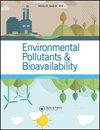工业废水中重金属的水平、固相组分和来源:一个案例研究
Q3 Chemical Engineering
引用次数: 5
摘要
摘要对某场址工业废水中重金属的污染程度、固相组分中金属的分布以及可能的金属来源进行了调查。采集0 ~ 5、5 ~ 25、25 ~ 50 cm不同深度的土壤样品,分析Fe、Mn、Cd、Zn、Cu、Ni、Pb的含量。在所有金属中,所有土壤样品均未检测到Cd含量。Pb和Zn的平均含量高于地壳中相应的普通范围值。铜和锌的最大含量高于荷兰最优值,但低于荷兰保护法目标值。Cu、Pb、Zn的最大含量均高于页岩平均值。研究最多的重金属大多存在于潜在的不稳定池中(50.0%),包括与碳酸盐结合的金属,Fe/Mn氧化物或有机馏分。富集因子(EF)结合主成分分析(PCA)和层次聚类分析(HCA)等多变量分析表明,土壤样品中Mn、Ni和Fe的伴生物主要来源于岩性。土壤样品中的Pb主要来源于人为源,而Cu和Zn则受自然和人为源的混合控制。上述结果表明,工业废水进入排土场增加了铅、锌和铜的污染水平,并增强了它们的潜在不稳定池,这可能是对环境质量产生潜在毒性影响的原因。本文章由计算机程序翻译,如有差异,请以英文原文为准。
Levels, solid-phase fractions and sources of heavy metals at site received industrial effluents: a case study
Abstract Heavy metals in the site received industrial effluents were investigated to assess the pollution levels, distribution of metal among solid-phase fractions and possible metal sources. The soil samples at different depths of 0–5, 5–25 and 25–50 cm were collected and analyzed for Fe, Mn, Cd, Zn, Cu, Ni and Pb. Among all metals, Cd content was not detected in all soil samples. The average contents of Pb and Zn are higher than the corresponding values of common range in earth crust. Meanwhile, the maximum contents of Cu and Zn are higher than those of Dutch optimum value but lower that the Dutch protection act target value. The maximum contents of Cu, Pb and Zn are higher than the average shale value. The most investigated heavy metals are mostly found in the potentially labile pool (>50.0%) including metal bound to carbonate, Fe/Mn oxides, or organically fractions. Enrichment factor (EF) in combination with multivariate analysis including principal component analysis (PCA) and hierarchical cluster analysis (HCA) suggest that Mn and Ni associated with Fe in the soil samples were primarily originated from lithogenic sources. Pb was largely derived only from anthropogenic source, while Cu and Zn in the soil samples were controlled by the mixed natural and anthropogenic sources. These results suggest that discharging the industrial effluents into dumping site increased pollution level of Pb, Zn and Cu as well as enhanced their potentially labile pool that may be responsible for occurring potential toxic impacts on environmental quality.
求助全文
通过发布文献求助,成功后即可免费获取论文全文。
去求助
来源期刊
CiteScore
1.62
自引率
0.00%
发文量
0
审稿时长
1 months
期刊介绍:
Chemical Speciation & Bioavailability ( CS&B) is a scholarly, peer-reviewed forum for insights on the chemical aspects of occurrence, distribution, transport, transformation, transfer, fate, and effects of substances in the environment and biota, and their impacts on the uptake of the substances by living organisms. Substances of interests include both beneficial and toxic ones, especially nutrients, heavy metals, persistent organic pollutants, and emerging contaminants, such as engineered nanomaterials, as well as pharmaceuticals and personal-care products as pollutants. It is the aim of this Journal to develop an international community of experienced colleagues to promote the research, discussion, review, and spread of information on chemical speciation and bioavailability, which is a topic of interest to researchers in many disciplines, including environmental, chemical, biological, food, medical, toxicology, and health sciences.
Key themes in the scope of the Journal include, but are not limited to, the following “6Ms”:
Methods for speciation analysis and the evaluation of bioavailability, especially the development, validation, and application of novel methods and techniques.
Media that sustain the processes of release, distribution, transformation, and transfer of chemical speciation; of particular interest are emerging contaminants, such as engineered nanomaterials, pharmaceuticals, and personal-care products.
Mobility of substance species in environment and biota, either spatially or temporally.
Matters that influence the chemical speciation and bioavailability, mainly environmentally relevant conditions.
Mechanisms that govern the transport, transformation, transfer, and fate of chemical speciation in the environment, and the biouptake of substances.
Models for the simulation of chemical speciation and bioavailability, and for the prediction of toxicity.
Chemical Speciation & Bioavailability is a fully open access journal. This means all submitted articles will, if accepted, be available for anyone to read, anywhere, at any time. immediately on publication. There are no charges for submission to this journal.

 求助内容:
求助内容: 应助结果提醒方式:
应助结果提醒方式:


